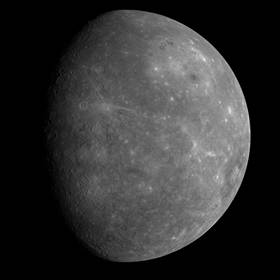|
SOUTHERN ASTRONOMICAL DELIGHTS
M E R C U R Y
Part 3 : VISITS by SPACECRAFT
|
Mariner 10 has been the only spacecraft to
approach the planet (2006), during the three flybys in February and
September 1974, and again in March 1975. Here we have gained most of
our meagre knowledge about Mercury. Disappointingly, this spacecraft
saw only 45% of the entire surface. Planetary astronomers also
detected its magnetic field that hints of a large iron core around
70% of the planetary mass. In 1994, Earth-bound radar observations
have also suggested that within some craters of Mercury are ancient
ice sheets near the north and south poles that have presumably never
seen sunlight.
MESSENGER
The last interplanetary visit to Mercury was by
the NASA 1.1 tonne Messenger spacecraft. (MErcury Surface,
Space ENvironment, Geochemistry, and Ranging.) Launched on 3rd
August 2004, this lengthy roundabout trip mission achieved final
orbit around Mercury in March 2011. Many gravity assists via
planetary encounters were required to make the correct trajectory
for the rendezvous and final orbit. By 2011, Messenger had orbited
the Sun fifteen times, approached the Earth once (August 2005),
Venus twice (24th October 2006 and June 2007), and passed Mercury
three times (January and 6th October 2008 and September 2009). The
first Messenger encounters happened on 14th January 2008 and for the
first time viewed the majority of the part of the planet missed by
Mariner 10. This first fly-by revealed improved images from the far
superior cameras, showing a heavily cratered surface that at first
glance seems more like the Moon. Several close-up images were
obtained showing many crater and various geological and impact
features. Readers here might like to look at the N.A.S.A.
Messenger Website.

Fig. 2 : Image of Mercury Taken by Messenger
During Its First Fly-By on 14th January 2008
Credit: NASA/Johns Hopkins University
Applied Physics Laboratory/Carnegie
Institution of Washington.
From September 2009, this dedicated mapping mission explored
the surface of Mercury for a whole year. It also analyse the
planetary magnetic field, mineral deposits, composition and surface
geology. Like Earth, we believe Mercury has a highly dense metallic
core, which makes up more than 70% its diameter.
Another important goal examined Mercury’s very thin gaseous atmosphere discovered
by Mariner 10. The cause of the thin atmosphere is likely the
intense solar radiation striking the surface material. It seems to
be composed of only five main elements; being oxygen, hydrogen,
neon, sodium and potassium. The actual process is presently not well
understood.
Other aims looked for evidence in the polar regions of ice
in craters not exposed to the solar radiation. Investigations
explored the effects of high temperature on the surface rocks,
and if these have been transformed into heavier and denser metallic
materials.
BepiColombo
Also currently another Mercury dedicated spacecraft, which is now
the final planning and construction stages by the European Space
Agency (ESA). This twin spacecraft mission is named BepiColombo and
Gaia, and is scheduled for launch in August 2013, However, this
ion-propelled mission will not reach the innermost planet until
September 2019. This dual mission has two quite different
specialised spacecraft, are presently known as the Mercury
Planetary Orbiter (MPO) and the Mercury Magnetospheric
Orbiter (MMO), and individually weigh 500kg and 250kg,
respectively. This advanced spacecraft will investigate for a year
or two the nature of Mercury surface from the polar orbits of
400×1500 and 400×12 000 kilometres. Like NASA’s Messenger, these two craft have to have
there instruments carefully protected from the powerful energies and
high temperatures so close to the Sun.
NEXT PAGE : Transits of Mercury
Last Update : 22nd September 2019
Southern Astronomical Delights ©
(2019)
For any problems with this Website or Document please e-mail me.
|










